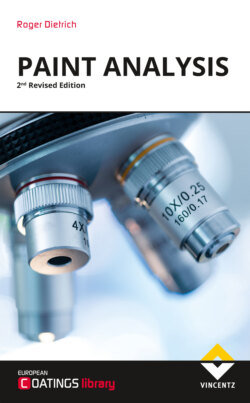Читать книгу Paint Analysis - Roger Dietrich - Страница 4
Foreword
ОглавлениеI am really glad that you found this book and opened it, curious to find out what to expect. This is the second edition of the book which was first published in 2009 and I can promise a lot of new interesting insights into field analysis and laboratory work with respect to coatings. Compared to the first edition you will find new techniques, additional advanced preparation and sampling methods and a lot of more practical examples. My intention was and is to share my experiences that I have made over the last 30 years in our laboratory and in the field with respect to the analysis of paints and coatings. I am a chemist and my approach to characterize a coating material, a raw material and coating failures is therefore primarily scientifically evidence based. I believe that is very important to have a profound insight into the basic, physical conditions and limitations of the analytical methods in order to comprehend their power and limitations. But I also have worked in the coating industry and know that is not always possible to investigate a problem extensively according to scientific rules. Therefore, I have tried in this second edition to shift the focus more to practical implications of analysing paints and coatings without neglecting the physical and methodical background. I added a section about sampling methods and representativeness because I have made the experience that the implications of proper sampling on the investigation result are too often disregarded.
Of course, you know the routine measuring and testing methods that tell something about colour, gloss and other physical conditions of paint films and coating material. These techniques provide the information how a certain material behaves. But they fail when it comes to the question why a tested material exhibits a particular property.
This is where this book comes in. I present a toolbox of analytical methods which exist for decades but have not yet found widespread use in the coating industry. However, I would like to demonstrate that the potential of the featured methods is incredibly big and far from being exploited.
The possible applications of the methods described here grow with the requirements of the samples to be examined. Almost every month a new question arises which can be answered with a process development based on the methods presented in this book.
Although I cannot deny my education as a chemist, the book is aimed at a broad group of users from the coatings industry. It is intended as an aid for the application engineer on site to start solving problems, but as well to provide the laboratory manager with suggestions for new ways of dealing with his tasks. I tried to build a bridge between the scientific view on the reality and the practical requirements on the site and in the applications laboratories.
I would like you to hold this book in your hands as a daily reference and tool, and to use it extensively to find out how you can
reveal the causes of coating defects,
investigate paint raw materials with respect to contaminations
or analyse lacquered products in terms of their properties
So, if after a short time this manual is lying on your desk or laboratory table with paint stains and marginal notes, I would be more satisfied. In the practical part of the manual I have, therefore, tried to structure and process the topics in such a way that you can draw immediate suggestions for action if, for example, paint craters occur when coating products or if you want to know whether and how two paint batches differ. Of course, this is backed up with theoretical principles in a separate chapter. But the problem solutions described in the practical part should ideally enable you, like a kind of “recipe”, to proceed directly to action with the book in your hand to tackle your daily challenges.
I do not see this book only as a handbook documenting the current state of the art, but I would like to use it to stimulate dialogues from which improvements of current procedures or perhaps even new developments can arise. I am therefore always open to suggestions and comments and hope to receive numerous feedbacks, which I will gladly take up and answer as soon as possible.
Münster, November 2020
Roger Dietrich
